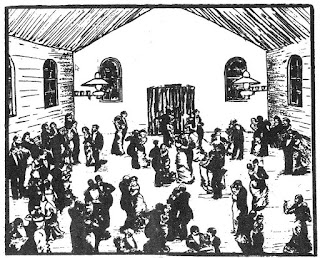 |
| Doncaster Athenaeum Gala Ball 1896 |
"If dancing can be shown to rest upon the eternal principles of grace and beauty, it will at once he raised to a dignified position among the arts." Queen Alexandra
When early western man wanted to dance he held out his hands to his fellows and they all joined together in a linked line. The line of dancers formed into a circle. The ring was the basis of dancing for many centuries. Modern social dancing developed from these ring dances of antiquity. In Provence during mediaeval times, couples emerged from the ring to dance together.
"Unless girls can dance decently they do not get partners. Men who are wretchedly bad dancers are clumsy and embarrassed on the ballroom floor. The correct thing to do is to learn to dance before accepting an invitation. Dancing is an opportunity for the young to get to know each other. When on the dance floor one can tell whether his or her partner evinces patience and possesses courtesy and charm. It is also an occasion to discover whether the other emits an obnoxious odour not unlike bad meat." From a 1780 treatise on dancing.
Renaissance man lived in a world in which he saw harmonious proportions everywhere. Dancing followed the principles of unity, proportion and clarity. It was important to harmonise with the heavenly rhythm. The direction that the dancers progressed around the dance floor was determined by the movement of the stars around the heavens. To move in the opposite way could hinder the stars in their courses.
"Learn them to dance And imitate the stars celestial; For when pale death your vital twist shall sever, Your better parts must dance with them forever." From "Orchestra" by Sir John Davies 1596.
Dancing has always been an expression of the life and customs of the time, and social changes have been ushered in with new dance steps. As with most things new, these dances were often met with suspicion and indignation. The Waltz was branded as immoral for the closeness of the partners, and indecent for its rapid movement which made the ladies perspire. In recent times Rock and Roll met a hostile reception.
During the 1920‘s the Foxtrot and Quick- step became the dances of the day. After the lively Polkas, the Galop, the energetic Lancers, the Washington Post and Schottzische, graceful rhythm had returned to dancing.
The long flowing gowns of the girls and the tail coats of the men emphasised the fluid curves of the dance.
The Twist and the Rock and Roll changed the old ballroom "close hold" position to partners being separated, much as they were in the days of the Minuet. The difference being the modern high-pitched way of life that has taken the place of harmony and rhythm.
At the end of last century, dancing became popular as a social entertainment in our district.
The Athenaeum Hall was built in Doncaster in 1870 and soon afterwards the Mechanics Institute at Templestowe. These halls were built for cultural purposes. Part of the evening entertainment would be dancing. At an Athenaeum committee meeting in 1880 a discussion was held to decide whether the dancing should be held before or after the poetry reading.
During the depression years of the 1890's, "All Night Balls" were held. Music was provided by a piano and violin. The musicians were hired from 8 pm to 5 am for 10/-d. each. It was at this time that a Quadrille Club was formed in Doncaster.
A few private houses had a piano or harmonium but often when a party was held in a private home the only music for dancing was a mouth-organ. If the musician wished to dance he held his partner with one arm while the other held the mouth organ as he danced around the room.
In the 1920's, Dances and Annual Balls were held in all centres of the district. There were RSL and Cricket Club Dances and at Warrandyte there was the Lilac Time Ball. The Foxtrot was the dance of the day but there was also the Royal Irish, Charmaine, Waltz, Gipsy Tap, Palma Waltz and always a marathon Barn Dance.
Source: Irvine Green writing in 1979 08 DTHS Newsletter and reprinted in 2017-12 DTHS Newsletter

No comments:
Post a Comment